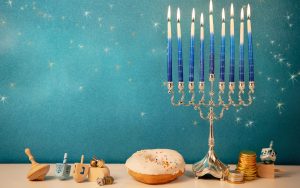 Something old, something new, something for school, and nothing for you – Hanukkah traditions are different around the world. Enjoy our round up of some of the most interesting traditions along with surprising facts for each of them.
Something old, something new, something for school, and nothing for you – Hanukkah traditions are different around the world. Enjoy our round up of some of the most interesting traditions along with surprising facts for each of them.
1. Candle Lighting. Since Hanukkah is the festival of lights and its main requirement is lighting the candles on the menorah, this is the most common way to celebrate the holiday in the home and in public. In fact lighting the menorah is how many world leaders show their support for Jewish communities. But what’s surprising is that this is also true in predominately Muslim countries like Morocco, where political leaders make their menorah-lighting rounds just like in everywhere else.
Fun fact: Bill Clinton lit the first menorah in the White House in 1993, during which the ponytail of a 6-year-old girl caught fire.
2. Greasy Food. If you’re American or European, you’re probably familiar with latkes, the oil-laden reminder of the miracle of oil. But what you might not know is that throughout the Middle East, Jewish people celebrate Hanukkah with all kinds of greasy food, especially “sufganiot,” which is the American equivalent of a jelly doughnut. These ever-present fat-laden treats make their appearance in supermarkets and bakeries a few weeks before Hanukkah and are an office-treat favorite.
Fun fact: The largest bakery in Israel makes over 250,000 sufganiot every single day during the 8-day Hanukkah celebration.
3. That Other Holiday on the 25th? With more Jewish people living in the diaspora than in Israel, it’s hard to ignore that big holiday on December 25th. Whether it’s happening on Thanksgiving, like in 2013, or will run right up until Christmas Eve, like in 2014, it’s hard to ignore the link between the two or the ubiquitous “Happy Holidays!” greetings. But maybe you didn’t know that Hanukkah starts on the same day every year – on the Hebrew calendar.
Fun Fact: Every year Hanukkah starts on the 25th – of the Hebrew month Kislev.
4. Show Your Lights! Perhaps you’ve seen menorahs in windows on display and thought that this was a takeoff of Christmas lights. This, however, is not true. Publicly displaying your Hanukkah menorah’s lights has been a tradition since the early days of Hanukkah. Widely revered Rabbi Rashi says that the purpose of this is to spread the news of the Hanukkah miracle.
Fun Fact: Traditionally, Hanukkah menorahs are displayed on the doorstep opposite of the mezuzah or in a window facing the street.
5. There is No One Way to Do It. One, Two, Three? How many menorahs do you see? Some families, usually Ashkenazi, have and light a menorah for each family member. Others have one per family. In some families, it’s the oldest woman who lights the candles, while it other’s it’s always the oldest man. Some families give this job to the youngest child capable of safely doing it. In short, each family has its own traditions on who lights the candles and how many menorahs they have.
Fun Fact: Many people wait for complete darkness to light their candles so that the lights do their duty of showing brightness in the dark.
6. Charity Time. For Jewish people living in the diaspora, Hanukkah time to give tzedekkah. Some children give their old toys to organizations that help needy kids and get nothing in return, while others do so in order to “make room” for the new Hanukkah gifts. There are many Christmas-related toy drives that make this tradition easy to join.
Fun Fact: December 31st is the last day for Americans to give to charities and get a tax deduction for the year, thus many charities run a Hanukkah fundraiser.
7. 8 Nights of Gifts. Wow! This sounds like a dream come true for present-loving kids. In America and many countries Jewish kids look forward to 8 nights of presents. For some houses, this means 8 nights of essentials, like socks, school pencils, art supplies, books, and anything deemed practical or educational. In other houses, gifts focus on reinforcing Jewish identity, like menorahs, Jewish books, or Judaica. And some families make it an opportunity for kids to get new toys.
Fun fact: Israelis give gifts for Passover and Rosh Hashanah. It’s even a part of labor law that workers employed for over a year must be given bonuses at Passover. But they generally give candy, books, music or play dreidels for Hanukkah.
8. Make a Wish! If you’re into Kaballah or place value in Hassidic thoughts on auspiciousness, you’re in luck – on the last day of Hanukkah. Called Zot Hanukkah, it’s thought of as a particularly good day to make requests.
Fun Fact: Zot Hanukkah means “This is Hanukkah” in Hebrew. In typical Jewish fashion, scholars disagree on why. Some scholars say that this is to emphasize that it’s still Hanukkah and that the day isn’t ambiguously Hanukkah, for other scholars have debated on whether the 8th day really is a part of the celebration. Other scholars say it’s because we’ve completed the entire time of Hanukkah, so now Hanukkah is truly complete. There are many other interpretations, but a general agreement is that the 8th day is special.












